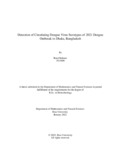| dc.description.abstract | Dengue infection is a self-limiting febrile illness caused by four serotypes of dengue viruses (DENVs). It is one the most important, yet globally neglected, vector-borne diseases in tropical and subtropical regions of the world, where its etiological agent’s mosquito vectors, female Aedes aegypti and A. albopictus are habituated. Due to rapid development of the world, in terms of urbanization and international travel, dengue has been on a staggering rise with regards to geographical distribution, frequency of outbreaks, and disease severity. During the monsoon season, many of the endemic and hyperendemic countries, including Bangladesh, are vulnerable to dengue outbreaks. While it mostly leads to silent or mild to moderate symptoms, disease severity is often increased with reemergence of a serotype of DENV following years of absence, especially in cases of heterologous secondary DENV infections. This makes identification of circulating serotypes, along with detection of the prevalent serotype(s), indispensable tools during times of potential outbreaks as it may lead to nationwide preparedness, thus, enabling the control or limitation of a potential epidemic. To address the issue, this study aimed to identify the prevalence of circulating serotypes of DENV in the recent 2021 dengue outbreak in Bangladesh. In this study, suspected dengue patients were enrolled whose blood was serologically tested for the presence of dengue NS1 antigen, and anti-Dengue IgM and IgG. Following RNA extraction with RNA Isolation Kit, presence of dengue RNA was then detected in the NS1 positive samples via real-time reverse transcriptase polymerase chain reaction (RT-PCR) using a commercial Dengue Virus Real Time PCR Detection Kit. Later on, another commercial Multiplex real-time RT-PCR Dengue differentiation kit was used on the isolated RNA positive samples for serotyping the DENVs in the samples. Accordingly, this serotyping study allowed the identification of the circulating serotypes, as well as the predominant serotype in the 2021 dengue outbreak in Bangladesh. This study found that DENV2 and DENV3 were the circulating DENV serotypes in the 2021 dengue outbreak in Dhaka, Bangladesh with DENV3 being predominant. It was also revealed that majority of the cases were secondary dengue infections. | en_US |

